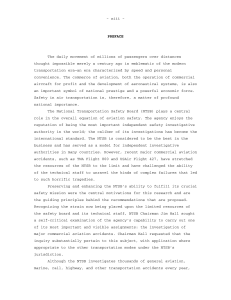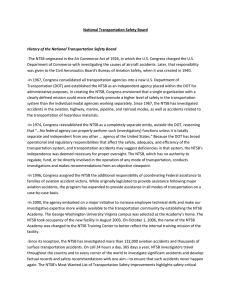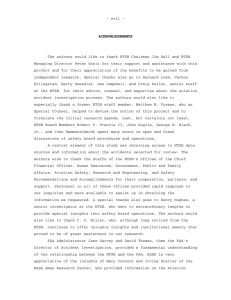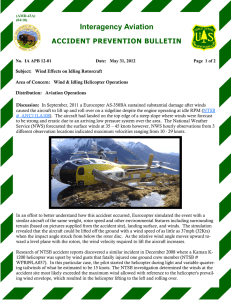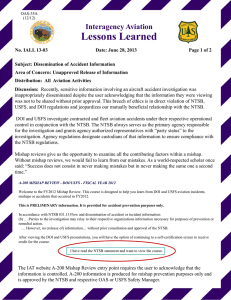- 1 - CHAPTER 1
advertisement
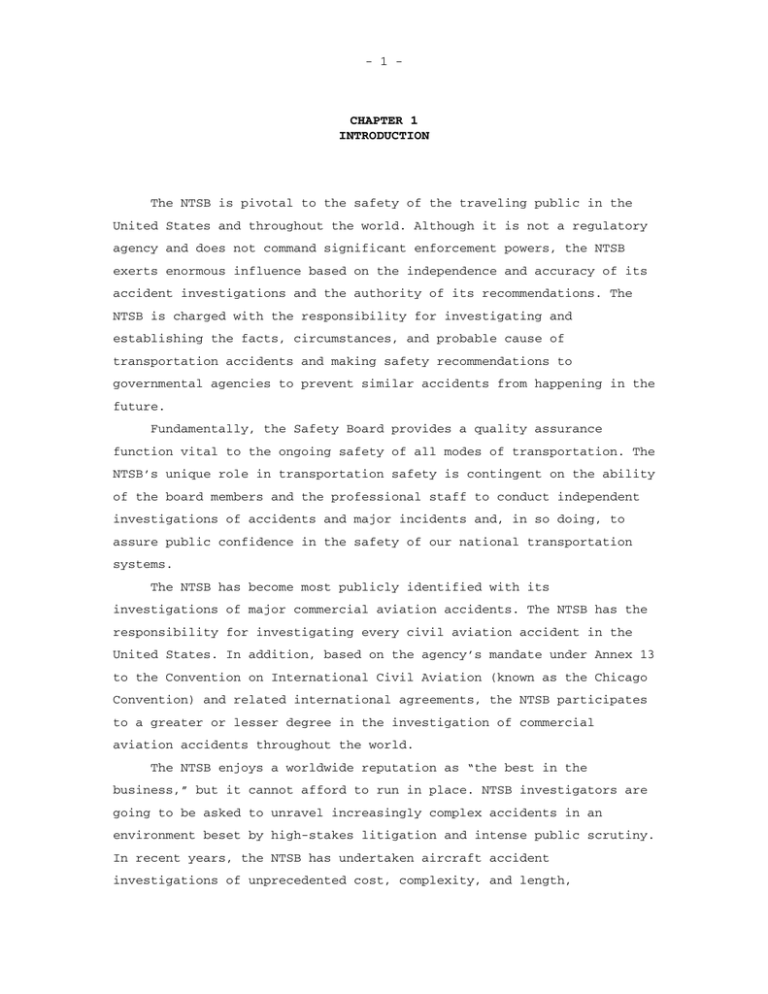
- 1 - CHAPTER 1 INTRODUCTION The NTSB is pivotal to the safety of the traveling public in the United States and throughout the world. Although it is not a regulatory agency and does not command significant enforcement powers, the NTSB exerts enormous influence based on the independence and accuracy of its accident investigations and the authority of its recommendations. The NTSB is charged with the responsibility for investigating and establishing the facts, circumstances, and probable cause of transportation accidents and making safety recommendations to governmental agencies to prevent similar accidents from happening in the future. Fundamentally, the Safety Board provides a quality assurance function vital to the ongoing safety of all modes of transportation. The NTSB’s unique role in transportation safety is contingent on the ability of the board members and the professional staff to conduct independent investigations of accidents and major incidents and, in so doing, to assure public confidence in the safety of our national transportation systems. The NTSB has become most publicly identified with its investigations of major commercial aviation accidents. The NTSB has the responsibility for investigating every civil aviation accident in the United States. In addition, based on the agency’s mandate under Annex 13 to the Convention on International Civil Aviation (known as the Chicago Convention) and related international agreements, the NTSB participates to a greater or lesser degree in the investigation of commercial aviation accidents throughout the world. The NTSB enjoys a worldwide reputation as “the best in the business,” but it cannot afford to run in place. NTSB investigators are going to be asked to unravel increasingly complex accidents in an environment beset by high-stakes litigation and intense public scrutiny. In recent years, the NTSB has undertaken aircraft accident investigations of unprecedented cost, complexity, and length, - 2 - exemplified by such high-profile accidents as TWA Flight 800 and USAir Flight 427. These investigations have stretched staff resources to the limit and have seriously challenged the expertise of NTSB investigators. The integrity of the NTSB’s accident investigation process depends on the independence and skills of the agency’s investigative staff, combined with the accuracy and thoroughness of the information provided by the organizations, corporations, and individuals designated to assist as “parties” in investigative proceedings. The Safety Board’s principal resource is its staff. Consequently, workload, staffing, and training are key determinants of the agency’s competence and proficiency. Constraints on budget, personnel, and technical resources have already posed a fundamental challenge to the agency’s ability to do its job. The continuation of “business as usual” will simply not be enough to ensure fulfillment of the NTSB’s critical safety mission. The NTSB must embrace new methodologies, new management approaches, and a new awareness of its working environment if future demands and expectations are to be met. This report addresses a number of issues relevant to the investigation of major commercial aviation accidents and outlines a specific agenda of actions to bolster the NTSB’s independence and to ensure that the safety board has sufficient resources to effectively investigate the kinds of accidents that are likely to occur well into the 21st century. A NATIONAL FOCUS ON AIR SAFETY On July 17, 1996, TWA Flight 800 with an early model Boeing 747 carrying 230 passengers and crew lifted off from New York’s John F. Kennedy International Airport bound for Paris. Minutes later, the huge airliner exploded and crashed into the waters off the eastern shore of Long Island. The terrific force of the explosion had torn the aircraft apart, and the disturbing recovery images, along with vivid eyewitness accounts, riveted the attention of a shocked American public for many weeks. It was an all too familiar scene. Only two months earlier, a McDonnell-Douglas DC-9 operated by ValuJet Airlines had slammed into the - 3 - Florida Everglades killing 110 people. With the aircraft on fire and losing control, the crew struggled to land the crippled airliner. The crash scene was particularly gruesome. These back-to-back crashes shook the foundation of the aviation community. The traveling public was frightened, and media pundits questioned the perceived safety of domestic airline operations. The Clinton administration reacted quickly. On July 25, 1996, President Bill Clinton announced the creation of the White House Commission on Aviation Safety and Security.1 Chaired by Vice President Al Gore, the commission set an aggressive agenda for reviewing the safety of the air transportation system and issued initial recommendations within two months. The final report, issued five months later, outlined sweeping changes calling for regulatory reform and additional research directed toward new and safer technologies. Most important, the commission’s report prescribed a national goal of dramatically reducing the risk of fatalities in the air (Office of the President of the United States, January 1997).2 Concerns over aviation safety expressed in the White House commission’s report were echoed by the report of the congressionally mandated National Civil Aviation Review Commission (popularly known as the Mineta Commission, chaired by former California Congressman Norman Mineta), issued in December 1997 (National Civil Aviation Review Commission, December 11, 1997). The report highlighted an industry analysis showing that existing accident rates and increasing demand for air travel could lead to an airline accident occurring somewhere in the world on a weekly basis. Clearly, aviation safety was a matter requiring renewed U.S. leadership and significant national investment. ___________ 1Initial concerns that an explosive device or terrorist activity had caused the crash of TWA Flight 800 prompted an early focus on the security aspects of aviation safety. 2The actual goal, embraced and refined within the FAA’s Strategic Plan, aims to “reduce the U.S. aviation fatal accident rate per aircraft departure, as measured by a three-year moving average, by 80 percent from the three-year average for 1994–1996” by 2007. An aircraft manufacturers group, the Commercial Aviation Safety Team, has joined the FAA in pursuit of this goal (Federal Aviation Administration, May 1998, p.2). - 4 - At the same time, the newly enacted Aviation Family Assistance Act of 1996 mandated the creation of the Task Force on Assistance to Families of Aviation Disasters, overseen jointly by the U.S. DOT and the NTSB. The TWA and ValuJet disasters had also unveiled the urgent need to find ways to improve the treatment of victims’ families by the government, the airlines, the legal community, and the media. Among other things, the White House commission requested that the task force review the accident investigation process utilized by the NTSB and its potential impact on families. The task force’s report, containing 61 separate recommendations, amounted to a blueprint for the appropriate treatment of families suffering such grievous losses (U.S. Department of Transportation and the National Transportation Safety Board, 1997). Noteworthy among the task force’s recommendations was a directive to the NTSB to “formally review” the party system, an essential element of the agency’s investigative process, which allows the companies and entities involved in the accident to participate directly in the NTSB investigation. THE ROLE OF THE NTSB IN AVIATION SAFETY From the perspective of the NTSB, the combined effect of these successive commission and task force reports was significant, raising important questions about the future mission and workload of the NTSB, as well as concerns about the agency’s investigative methods and operations. The NTSB’s mission is primarily proactive--the prevention of transportation accidents--yet the agency accomplishes this mission primarily by being reactive in responding to catastrophic events. The NTSB’s goal is to improve quality (safety and performance) through the analysis of failure (the crash of an aircraft). When defects are found, the NTSB issues recommendations that can have profound effects on how aircraft are designed, manufactured, and operated. Because U.S.-made aircraft are sold and operated worldwide, suggested improvements from the NTSB have international implications for air safety. Over the years, the NTSB’s many safety recommendations, synthesized from tragic events, have helped bring the performance of the - 5 - National Airspace System (NAS) to its current state of high performance and reliability. Following the crash of Korean Air Flight 801 in Guam on August 6, 1997, killing 228 passengers, no fatal domestic commercial aviation accidents took place until the June 1, 1999, crash of an American Airlines MD-80 airliner in bad weather in Little Rock, Arkansas, killing 11 people.3 This 22-month hiatus in major accident events lulled some policymakers into believing that issues related to aviation safety, at least on the domestic front, had been adequately addressed. Whether this pause in fatal accidents was due to increased government and industry vigilance, or simply the highly stochastic nature of aircraft accidents, will never be known. However, even if aviation accidents become relatively rare events, the role of aviation accident investigation is germane to this study. What will the NTSB investigate if fewer planes crash? Of course, the NTSB investigates accidents in all transportation modes, but the lion’s share of its efforts and its public identity are tied to aviation. The answer to this mission-related question could fundamentally change the form and function of the NTSB in the years ahead. Both inside and outside the NTSB, concerns have also been expressed that the safety board is becoming fragmented and is operating at the limits of its capability. In recent years, the NTSB has undertaken aircraft accident investigations of extraordinary cost, complexity, and length. The investigation of the crash of TWA Flight 800 is still not complete, almost four-and-a-half years later as of this writing. The investigation of another high-profile accident, the crash of USAir Flight 427 in 1994, took more than four years to complete, yielding a conclusion that was technically controversial and circumstantial. These crash investigations mark some clear trends. They demonstrate that when modern airplanes--machines developed with highly integrated systems and high orders of complexity--crash, the subsequent ___________ 3During the 22-month period following the crash of Flight 801, several major commercial aviation accidents occurred worldwide, most prominently the crash of Swissair Flight 111, involving a McDonnellDouglas MD-11, near Halifax, Nova Scotia, killing 229 people traveling from New York to Geneva, including 137 Americans. - 6 - investigation is likely to involve commensurate levels of complexity. NTSB investigators can quickly become the target of intense media attention and face new sources of criticism and alternative accident theories, especially those flooding in via the Internet. Finally, the economic stakes have never been higher. Today, a major accident can expose manufacturers and operators to enormous potential losses. Companies suffer costly mandated repairs and modifications to aircraft or operating procedures, multimillion dollar liability claims, and the loss of international market share. The magnitude of potential loss can be so high as to call into question the commitment of private parties to full disclosure and technical objectivity during investigations. Because the NTSB has historically depended on the openness of private firms involved in a crash, any change in behavior would significantly affect safety board investigative practices and organizational capabilities. These factors combine to bring into focus the technical practices, staff capabilities, and operational methods of the NTSB. Can the NTSB, as currently chartered and operated, deal with modern aviation accidents? Can its traditional relationships with stakeholders in the aviation community continue to operate reliably in such a highly litigious environment? These questions make it clear that the NTSB is facing a period of dramatic change. Such realities motivated RAND’s detailed review. OBJECTIVES OF THE STUDY The chairman of the NTSB asked RAND to address two important issues at the heart of the NTSB investigative process: the Safety Board’s interaction with external parties during an investigation and the ability of its internal staff to be trained to meet existing and emerging challenges. These issues are closely related, as the research came to clearly demonstrate. Ultimately, RAND’s analysis looked closely at the internal operations of the NTSB and carefully examined its relationship with outside stakeholders in the aviation community. Leadership is a central theme of NTSB operations, providing the essential connection between staff capability and the ability to manage - 7 - and direct major investigations. From its inception, the Safety Board was viewed as an agency to lead accident investigations, in concert with the outside parties involved in a crash--that is, the airline, the aircraft manufacturers, air traffic control, airport operators, and others. This is the essence of the party process. It is the core modus operandi for the NTSB’s investigation of all transportation accidents. The centrality of the party process reflects an appreciation, on the part of legislators and other policymakers, that an agency capable of operating with complete autonomy would be impossibly large, unwieldy, and costly considering the diversity of accidents that the Safety Board is called upon to investigate. The NTSB must work with parties involved in a crash because its in-house expertise is not sufficient. However, this presents a clear and present danger to the integrity of the investigative process--parties that face potentially enormous economic losses if they are found to be the cause of an accident could attempt to disrupt or bias an investigation. Two basic tenets underpin this somewhat risky policy choice: • The Safety Board staff must manifest exceptional skill and expertise, combining leadership in relevant technical areas with superior investigative talents and management abilities. The NTSB’s principal resource is clearly its staff. How this staff is recruited, maintained, and trained ultimately ensures, more than any other factor, the timely and accurate resolution of transportation accidents. • The parties to an accident investigation will participate openly, honestly, and with the highest level of integrity, prompted by the notion that safety will be furthered by the expeditious determination of the cause of an accident. Although the second of these principles is necessary to fulfillment of the NTSB’s investigative goals, it is not sufficient in the absence of the Safety Board’s exercise of leadership through the excellence and expertise of its staff. Should either tenet be violated, the credibility of the Safety Board’s product--that is, the findings of cause and safety recommendations--would become suspect. RAND’s research can be summarized as a review of these two fundamental tenets of NTSB operations. - 8 - The research examined two aspects of the agency’s operations: • NTSB practices and policies with regard to the training and qualifications of aviation accident investigators, including a determination of the adequacy of such policies and practices in light of future technological developments in aviation. • The functioning of the party process as a means of supplementing NTSB skills and technical knowledge, including an examination of the liability environment in which the party system operates. It is important to note that a strong feeling of general concern about the NTSB surrounded these specific research objectives. RAND encountered a consistent uneasiness regarding the ability of the NTSB to generate timely and accurate results. Many observers and stakeholders openly expressed a belief that the NTSB’s technical capabilities had been seriously eroded and that investigations were being hampered by an overloaded staff that was increasingly insulated from the aviation community. Individuals inside and outside the NTSB expressed these concerns. Many stakeholders cited, for example, growing tension between the NTSB and aviation regulators at the FAA. Others expressed concern that the NTSB’s limited staff was no match for the opposition--large commercial firms facing huge potential losses. Inevitably, the information acquired during the course of this research, as well as the resulting findings and recommendations, expanded to incorporate some of these broader questions. RAND worked with NTSB senior managers specifically to augment the scope of the research in selected areas. For example, while original study objectives called for an examination of NTSB training policies, it quickly became apparent that maintaining a capable staff does not depend only on training but is also influenced by hiring policies and staff workloads. The scope of work was subsequently expanded to address hiring and workload issues. In the course of the research, RAND also noted many areas in which internal NTSB practices either inhibited the hiring and training of staff, added to an already heavy workload, or caused - 9 - breakdowns in communication with parties involved in investigations. These issues are summarized in this report. The breadth of the research should also be noted. Resource limitations demanded that RAND focus its analysis on aviation accidents, largely ignoring the four other areas of NTSB authority.4 Many of the observations made in this report have relevance to these other modes of transportation; however, wholesale extrapolation of the findings and conclusions of this report beyond the sphere of aviation should be avoided. Where possible, RAND has attempted to identify areas applying to the NTSB at large. Finally, the depth to which these objectives could be explored was, of course, limited by funding. Some aspects of the research could only be touched upon, leaving others inside or outside the NTSB to expand upon the themes RAND identified. In such cases, RAND characterized the issues for the NTSB and recommended additional research and analysis with more focused objectives. RESEARCH APPROACH A study of this magnitude clearly pointed to the need for a multidisciplinary research approach. RAND selected personnel from several different RAND programs, including the Institute for Civil Justice, the Science and Technology Policy Institute, and Project AIR FORCE. The project’s staff included aeronautical engineers, public policy analysts, and an attorney to address the diverse set of issues the NTSB presented. The analysis examined external factors influencing NTSB operations such as the volume and type of accidents, advances in technology, and the legal environment, and internal factors such as the policies and procedures the NTSB follows to staff and train its workforce and to conduct its investigations. ___________ 4The Safety Board also investigates accidents involving (1) railroads; (2) interstate buses, interstate trucking, and other highway accidents selected in cooperation with state authorities; (3) pipelines and hazardous materials; and (4) marine accidents (in conjunction with the U.S. Coast Guard). - 10 - RAND created a five-phase research plan to identify critical issues and illuminate the various challenges facing the NTSB. The analysis created a historical perspective of the NTSB and exhaustively studied current procedures and capabilities. Proposed solutions must, however, provide the NTSB with the flexibility it needs to meet future demands and the changing nature of air accidents. With this in mind, RAND paid close attention to the environment in which the NTSB will operate in the future. The five phases of the research plan consist of • Baseline development--the analysis of information about the NTSB’s operating budgets, staff size, accident volumes, and duration of investigations • Emerging environments--an assessment of how the aviation environment is likely to change and how the changes could shape NTSB operations • Liability environment review--an examination of the current civil legal system as it affects the settlement and litigation of aviation accident cases and the behavior of stakeholders in the party process • Staffing and training review--an analysis of current staffing and workloads and the state of accident investigator training • Internal process review--a critical assessment of the internal management and operating processes in use at the NTSB. RAND quickly determined that the NTSB had a limited amount of quantitative data. These data were often of insufficient fidelity to support analyses of the magnitude intended in the research plan. The research team acquired as much NTSB financial and staffing data as could be obtained through a reasonable expenditure of project funds. The team also acquired accident statistics and information about the status of investigations and integrated that information to form an initial baseline characterization of the Safety Board. RAND used internal NTSB records on personnel, workload, training, budgets, accidents, and accident reports to characterize NTSB operations. Typically, these records could not be used directly and had to undergo a considerable amount of processing before they could be - 11 - employed to answer research questions. To augment the NTSB’s quantitative data, RAND relied on the following research methods: • Structured questionnaire. RAND created a confidential survey instrument and distributed it to all professional staff (not limited to aviation) at the NTSB headquarters in Washington, D.C., and the NTSB’s field and regional offices. Quantitative analysis of the responses to this questionnaire provided additional information about the NTSB staff that standard management information systems do not normally capture. Results were subjected to statistical tests to characterize the degree of uncertainty arising from the response rate.5 • Structured interviews. RAND interviewed board members and senior management and technical staff at the NTSB’s headquarters and regional offices. Representatives from a broad cross section of stakeholders in the aviation community were also interviewed, including defense and plaintiff attorneys, insurers, air safety educators, air carriers and GA manufacturers, airline training personnel, aviation researchers, union representatives, families of accident victims, government regulators and policymakers, Canadian and European accident investigators, and European aircraft manufacturers. • Legal review. RAND reviewed available legal materials related to the NTSB investigative process, including applicable federal regulations, published and unpublished judicial opinions, legal treatises, and legal periodical materials. • Site visits. In addition to frequent visits to NTSB facilities, RAND visited the reconstruction of TWA Flight 800 at the NTSB site at Calverton, New York; National Aeronautics and Space Administration (NASA) research facilities; large and small aircraft manufacturing sites; flight simulation facilities; and ___________ 5For a more complete description of the RAND skills and experience questionnaire administered to the NTSB staff and a detailed analysis of the survey results, see Appendixes D and E of this report. - 12 - aviation safety schools to gain firsthand knowledge of the environment in which accident investigations take place. • Case studies. RAND selected a set of case studies to review NTSB procedures and practices. Accidents were selected that taxed NTSB resources, either technically or organizationally.6 • Workshops. Three workshops were held with stakeholders from government and industry, senior government aviation officials, and families of accident victims to discuss many disparate viewpoints. These workshops were conducted without attribution to facilitate the free exchange of information. Additionally, RAND relied on extensive telephone interviews, an exhaustive literature review, and extensive use of Internet-based quantitative and qualitative data to augment the methods listed earlier. Collectively, the numerous data sources provided a rich set of information with which to perform case studies and other more quantitative data analysis that addressed project objectives. ___________ 6A list of the accident investigations in the case study set can be found in Appendix F.
